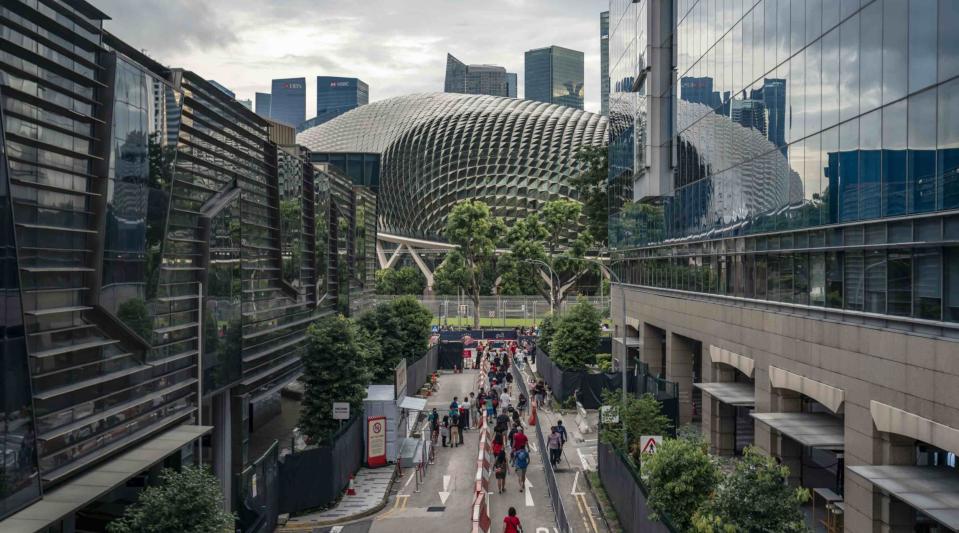Hospitality S-REITs entering 'multi-year upcycle' with 'travelanche' of Chinese travellers: DBS

DPUs will recover to 106% of levels in FY2024, which will more than compensate for higher interest rate risks, say DBS's analysts.
Hospitality Singapore REITs (S-REITs) are “well-benched” to ride the “travelanche” of Chinese travellers when they return, say DBS Group Research analysts Geraldine Wong, Tabitha Foo and Derek Tan.
Chinese travellers are the long-awaited last piece of the travel puzzle, say the DBS analysts, as they account for 30%-35% of Asia’s inbound market share. Closer to home, hotel S-REITs have some 77% exposure to China-positioned travel markets.
“Forward-leading indicators show that Chinese travel demand recovery will be fast, wide and furious, albeit from a low recovery base. Pent-up travel demand will spillover to neighbouring Asia Pacific (APAC) countries such as South Korea, Japan and Vietnam, where China was the number one source market making up 30%-35% of the total inbound market as well as leisure-positioned destinations in the likes of Maldives,” say the analysts in an April 4 note.
The recovery of S-REITs will be swift, according to DBS’s analysts. The sector’s revenue per available room (RevPAR) recovery was already at 94% of 2019 levels last year, ahead of DBS’s base case scenario. “Our bull case scenario could see sector distribution per unit (DPUs) recovering to 106% of normalised levels in FY2024, which will more than compensate for higher interest rate risks.”
While investor sentiment could be constrained by recessionary risks on the horizon, the impact is less than feared, says DBS. In addition, subdued room supply in the market will be key to maintaining “sky-high rates” in the coming years.
DBS’s preferred names to ride this upswing in tourism are CapitaLand Ascott Trust (CLAS) HMN and CDL Hospitality Trusts (CDLHT) J85, with target prices of $1.30 and $1.60 respectively.
Backloaded 2023
Recovery is likely to be backloaded in FY2023, says DBS, as Chinese airlines take time to reinstate international capacity.
China’s weekly international seat capacity, which measures airline routes and seat availability to international destinations, has started to trend upwards but remains considerably lower than pre-Covid-19 levels. While international seat capacity barely passed the 10% recovery mark in January, Chinese airlines have been rapidly increasing international flight capacity to keep up with growing Chinese outbound travel demand, say the analysts.
Among the big market players, Air China’s flight capacity for international routes has almost doubled y-o-y in February, while China Eastern and China Southern more than quadrupled and tripled their international capacity respectively, albeit from an exceptionally low base.
Looking ahead, China’s weekly international seat capacity is set to recover to 45% of 2019 levels in August based on estimates, says DBS.
DPU to recover
Hotel S-REITs posted FY2022 DPU at 62% of 2019 levels, mostly supported by much stronger DPUs in 2HFY2022, says DBS. “Our base case scenario will see sector-wide DPUs recovering to 75% of 2019 levels in FY2023 and subsequently 86% of 2019 levels in FY2024, while higher interest rate estimates would shave off 14% of DPUs on a comparable basis.”
Further, DBS’s bull case scenario sees DPU recovery surpassing 2019 levels to come in at 106% of pre-Covid-19 levels, more than compensating for higher interest rates.
Bearing in mind the hawkish interest rate environment, a further 50 basis points (bps) increase in the average interest cost will still see DPU recovering to 83% of 2019 levels by FY2024, according to DBS.
“This reinforces our view that the downside risk looks relatively limited, at -3% of our DPU estimates, as opposed to the upside growth potential for the sector,” note DBS’s analysts. “Correspondingly, sector target price (TP) will shift to a higher price-to-book band of c.1.1x-1.3x, implying a further upside to our current TPs for the sector in the range of 0.9x-1.2x.”
Early part of a multi-year upcycle
DBS thinks investors have levied negative sentiments onto the hospitality sector, while overlooking the robust topline and DPU recovery. “Reduced tenant quality and erosion of capital values for the hospitality sector are risks that we do not believe will overshadow growth, given this sub-sector’s ability to fend off these pressures across the trough pandemic years, compared to other sub-sectors.”
Most hospitality S-REITs are trading below book at 0.7x-0.9x, and DBS anticipates that stronger cash flows in FY2023 will continue to support capital values for 2023 while the sector could re-rate to trade above its historical mean of 0.9x and closer to its book values.
DBS prefers the likes of CDLHT and CLAS, “which would ride on the strong recovery in RevPAR in their global portfolios”. “CDLHT’s exposure in key leisure destination markets in the likes of Maldives and Japan will bode well for sustained strong RevPAR in 2023, while its primary geographical focus in Singapore will shield it well against exchange rate fluctuations and potential cap rate erosion that tilts towards assets abroad.”
Meanwhile, CLAS continues to be well-built to face recessionary pressure with its current 20% long-stay lodging segment alongside master lease agreements, say DBS’s analysts. “From a valuation and yield perspective, CLAS continues to feature well in terms of both growth and forward yield prospects (6.6% in FY2024) for a large-cap name.”
As at 9.58am, units in CDLHT are trading flat at $1.21, while units in CLAS are trading flat at $1.05.
See Also:
Click here to stay updated with the Latest Business & Investment News in Singapore
RHB expects MAS to increase slope of the S$NEER path to 2.0% at upcoming April meeting
'Buy' data centre S-REITs while they are under pressure from distressed tenant: DBS
Get in-depth insights from our expert contributors, and dive into financial and economic trends

 Yahoo Finance
Yahoo Finance 